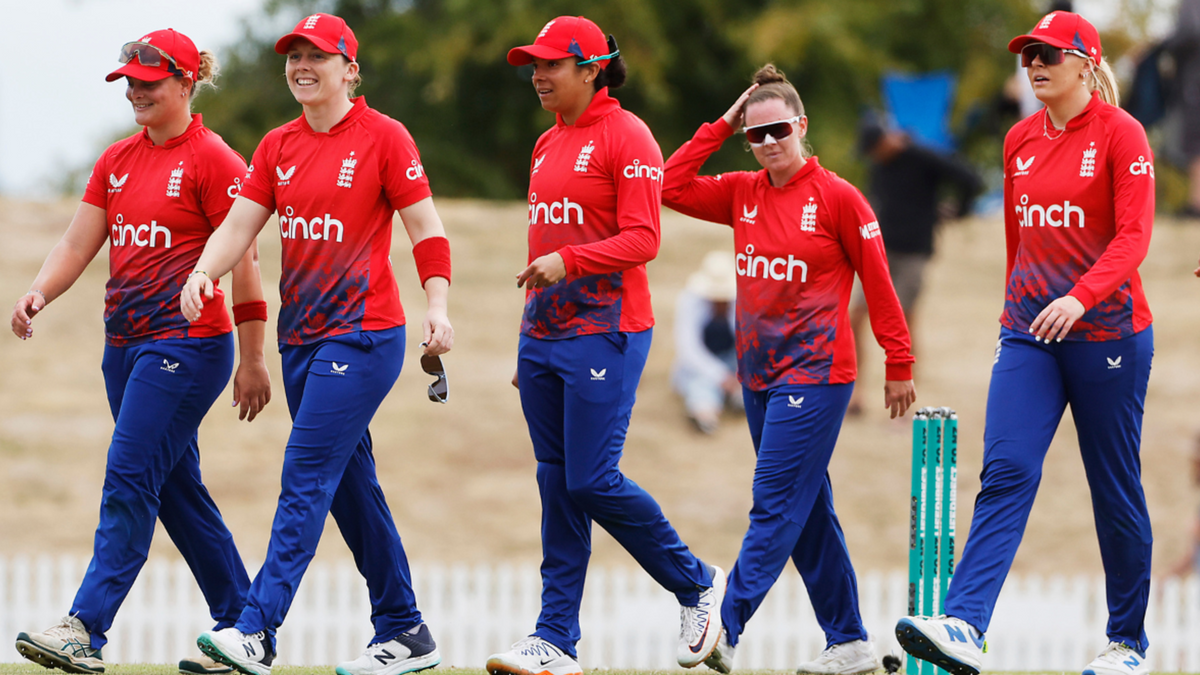
England have an established core of players already locked in for the T20 World Cup, but they lack depth from those coming up behind, writes Katya Witney.
Heather Knight is in a purple patch of T20I form. Having hit a superb 63 off 39 balls in the first T20I of the series, she reached another half-century in the second in Nelson last night (March 22). The two knocks were different in their approach, but both were integral to England winning each of those matches.
In the first, Knight came in at the beginning of the ninth over with two wickets down and 61 runs already on the board. With time to take stock, a couple of overs of calm followed before the boundaries began to flow. By the end of the 16th over, England’s run rate was pushing eight, and the partnership between Knight and Maia Bouchier was worth 63 off 48 balls. Two overs later, Knight whacked two fours and a six off Lea Tahuhu, 18 runs coming from the over. Following those early couple of overs readjustment to a slow pitch, Knight ensured England got up to a more than reasonable assessment of a par score.
Last night, the feeling was different. Coming in during the sixth over at 34-2, this time Bouchier was out nine balls later. Amy Jones followed quickly afterwards, with Dani Gibson and Bess Heath falling within five balls. Having attacked early on, Knight went back into her shell as the wickets fell. After hitting a six off the first ball of the ninth over, she didn’t hit another boundary until the 16th. By that point, she was on 22 off 24 balls. As the wickets dried up, however, the shackles came loose. England put on 49 runs in the final four overs of the game, with Knight reaching a third consecutive T20I half-century in the penultimate over.
Without those innings, there’s a likely chance that England would’ve lost both the first two matches of the series. Knight played a similar role in the third T20I in India last December, but her 52 off 42 balls was unable to make up for seven single-digit scores in England’s batting lineup (including four ducks), and the match ended in defeat.
Knight’s run of form is welcome, with her last three innings representing, remarkably, the only times she has passed fifty in T20Is outside of Canberra, where she has done so on four occasions. But the performance of England’s batting lineup outside their established core is becoming impossible to ignore. Against Sri Lanka last summer, India in December, and now in New Zealand, England have either had to or chosen to look to second-string or peripheral players. Against Sri Lanka, that ended in defeat, two months after England’s top brass had beaten Australia in a T20I series for the first time in five years. While testing out a range of options is useful considering the depth needed to win international tournaments and provide the foundations for the future, it’s exposed a significant performance gap.
Since October 2022, Danni Wyatt, Nat Sciver-Brunt, Alice Capsey (none of whom are available for the first three T20Is in New Zealand due to their WPL commitments), and Knight – all of whom are certs to start in the T20 World Cup later in the year – have 12 fifties between them. The rest of England’s batters have one. Sophia Dunkley, Amy Jones and Maia Bouchier, are the only batters to pass 25 in that time.
Dunkley’s struggles are well documented. She’s come into New Zealand with her place under fire, Tammy Beaumont at the other end as a constant reminder that she’s in a straight shootout for the second opener spot. A five-ball two in Nelson after a start in Dunedin hasn’t helped her ambitions. Her own performance aside, it might become significant for her that Beaumont hasn’t found her feet back in the T20I side yet, albeit with a two-innings sample size. Determining a winner from that shootout based on lack of complete failure rather than success is not the position England would have wanted to be in by the time of Wyatt’s return.
[breakout id=”0″][/breakout]
Bouchier, by far the most experienced of England’s bench options, made an important 43* in Dunedin. Having been given an extended run lower down the order in 2022 after Dunkley moved up the order, it could again be a Dunkley-related change that creates a spot for her back in the side. Nevertheless, Bouchier still has yet to pass 50 in 18 T20I innings and, since the beginning of 2022, has made one score of more than 25 in 16 innings. Despite her huge potential, the substance isn’t there yet.
Then there’s the rest. Dani Gibson, still early in her T20I career, has a top score of 21 batting down the order at No.6 and No.7 and has been dismissed for single-figure scores in four out of her eight innings to date. Bess Heath, having taken over as Jones’ understudy with the gloves has an even smaller sample size of innings to draw from, returning scores of one and two in the final match of the India series and in Nelson last night respectively.
While the performance gap is the pressing question, the experience gap is another. Outside of the core of players, Bouchier is the only top-six batter to have played eight T20I innings for England since the beginning of 2022. Going into a World Cup in Bangladesh, where bouts of sickness are common, alongside injury risks from increased workloads, the difficulties translating potential into international success should be lingering on the England management’s minds.
The early part of this series was an opportunity for those peripheral players to make a success of that translation against a New Zealand side in transformation. But, as of yet, they’ve been unable to do so.








